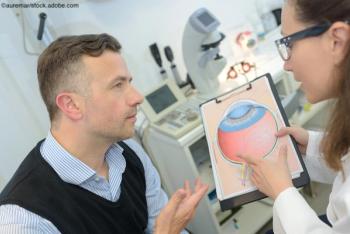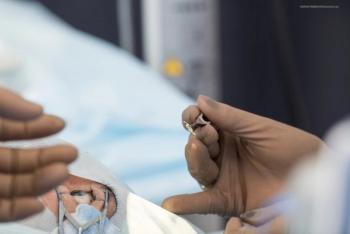
Why it is that ophthalmologists who read the same papers in the same journals have such widely varying approaches?

Why it is that ophthalmologists who read the same papers in the same journals have such widely varying approaches?

Ocular blood flow has been associated with the incidence, prevalence and progression of glaucoma, but its potential causative role remains a subject for debate. Better insights may be on the horizon using OCT angiography and sophisticated mathematical modeling techniques.

Transepithelial topography-guided PRK can help correct irregular astigmatism after penetrating keratoplasty.

Pattern electroretinography (PERG) and visually evoked potential (VEP) tests can objectively evaluate the function of axion and retinal ganglion cells. These test results can add another component in successfully treating patients with cataract and/or glaucoma.

Aqueous angiography facilitates increased understanding of aqueous humor outflow that can provide individualized treatment for IOP control.

After being in the field for 35 years, I still wonder, “What is it with these people?” Here are a few other examples of what I learned from those instances.

The European Commission has approved adalimumab (Humira, AbbVie) as the first biologic treatment for chronic non-infectious anterior uveitis in paediatric patients from 2 years of age who have had an inadequate response to conventional therapy.

So far, 2017 has been a very exciting year for both ophthalmology and healthcare as a whole. We still have a few months left for more excitement, so stay tuned!

A new small-aperture intraocular lens (IOL) extends patients’ depth of focus as well as multifocal IOLs with fewer dysphotopsias, researchers say.

Scleral tunnel, “glued” fixation technique works better than alternative fixation techniques in cases where intraocular lenses (IOLs) cannot be placed in capsular bag or in the sulcus, according to Sumit Garg, MD.


The most recent analyses of data from the ARMOR (Antibiotic Resistance Monitoring in Ocular micRoorganisms) Surveillance Program can guide clinicians choosing antibiotic therapy for initial empiric therapy and infection prophylaxis. The information also reinforces the importance of prudent antibiotic prescribing to limit the development of bacterial resistance to existing options, according to Penny Asbell, MD.

Ophthalmology Times wants insight on antibiotics and eye infections from clinicians in the field - so the editors asked you. Readers like you helped by completing our survey and telling us about your experience with postoperative infections after eye surgery, if you use topical antibiotic prior to cataract surgery, how you choose antibiotics in a routine surgical prophylaxis, and more. The 118 U.S.-based ophthalmologists who responded were entered into a drawing to win a $200 gift card, with the winner being an ophthalmologist in Houston.



Patient excellence training should focus more on how to build a human connection while entering data into a terminal than how to use the latest and greatest diagnostic equipment. People over the age of 35 are either looking for life balance (in the case of a Millennial) or that respect he or she had in the professional arena before retirement (in the case of Baby Boomers.)



Though extended depth-of-focus lenses tend to be more forgiving of residual refractive error and mild decentration than other presbyopia-correcting IOLs, it is important to select patients carefully and follow good preoperative protocols for a successful outcome.

Addressing patient dissatisfaction after presbyopia-correcting IOL surgery requires listening to understand the problem. Time and patient reassurance may be adequate for resolving some issues.

The idiom “Don’t bring a knife to a gunfight” is meant to convey the importance of not entering a challenging situation without the proper equipment at hand. The concept that one must come properly prepared and equipped to any important task or confrontation is well-appreciated by ophthalmic surgeons, but this particular expression is rarely used by ophthalmologists teaching eye surgery to residents.

Surgeons should use a centroid value for surgically induced astigmatism rather than a mean or median value when working with toric IOL calculators.

When exploring novel treatment options for the management of IOP, clinicians should consider a number of independent factors ranging from beneficial behaviors to body position.

When it comes to recommending a premium IOL, a patient’s glaucoma is only one factor to consider. Just like any other patient planning cataract surgery, visual needs and preferences for/against glasses are also important factors.

Residual astigmatism is not uncommon after toric IOL implantation. Depending on its cause and magnitude, lens reorientation may be a good solution.

A 4-year study following trifocal IOL implantation (AT LISA tri 839MP, Carl Zeiss Meditec) found that the lens provided good distance, near, and intermediate visual acuity. The lens also improved patient quality of vision with better diffraction and less reduction in contrast sensitivity.

One thing has remained constant since the inception of Google: the importance of unique and compelling content. So, the answer seems to be just keep adding content to your website-right? Unfortunately, no.

Cataract and refractive surgeons should use prophylaxis to avoid reactivation of the herpes simplex virus (HSV) in patients with a history of infection with this virus, according to Elizabeth Yeu, MD.

Tomasso, a vitreoretinal surgeon, recently shared a blog by someone who calls him/herself “Neuroskeptic”.Neuroskeptic penned a spoof “scientific” article about midichlorians, which are the little organisms inside cells that give Jedi Knights (the good guys in the “Star Wars” movies) their powers (and unfortunately, confer those same powers to certain bad guys, like Darth Vader).